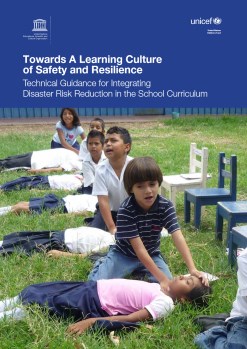Towards a Learning Culture of Safety and Resilience, a pathfinding document by David Selby and Fumiyo Kagawa – the outcome of a UNESCO/UNICEF consultancy to develop technical guidance for ministries of education, other educational jurisdictions, international and national non-governmental organizations and those in multiplier positions within education – has now been made available in pilot version on the UNESDOC website.
Over some 192 pages, Towards a Learning Culture of Safety and Resilience:
- Offers a rationale for disaster risk reduction education (DRRE), explaining the benefits of introducing disaster risk reduction (DRR) into school curriculum within an education for sustainable development (ESD) frame and, more broadly, within a quality education framework that also includes climate change education, life skills education and child friendly education
- Includes a typology and discussion of different approaches and strategies for integrating DRR across the curriculum and through the grade levels
- Gives guidance on progressing DRR curriculum development
- Gives guidance on formulating and sequencing DRR learning outcomes and competencies
- Explains the practical steps to be taken in developing DRR learning programs, activities and materials as well as teachers’ guides
- Guides teachers on the facilitation of interactive and participatory DRR learning inside and outside the classroom as well as means to enliven learning in textbook-driven or no-textbook learning contexts
- Looks at effective DRR professional development for teachers, principals, inspectors and others with a curriculum support role
- Introduces the idea of the DRR ‘reflective practitioner’
- Explores the concept of the DRR ‘learning organization’ where DRR curriculum and DRR campus and community aspects are mutually embedded
- Provides benchmarks and reference standards for monitoring and evaluating student progress
- Provides case study examples of successful integration of DRR into school curricula and practice
- Shows how to develop links and synergies with worldwide DRR in education initiatives
- Offers guidance on scaling up and mainstreaming of DRR curriculum initiatives within national education systems
- Shows how to monitor and evaluate DRR curriculum change, demonstrating the application of indicators and emphasizing stakeholder engagement,
To access the guidance document, click here.
To learn more about the piloting of the document, click here.

